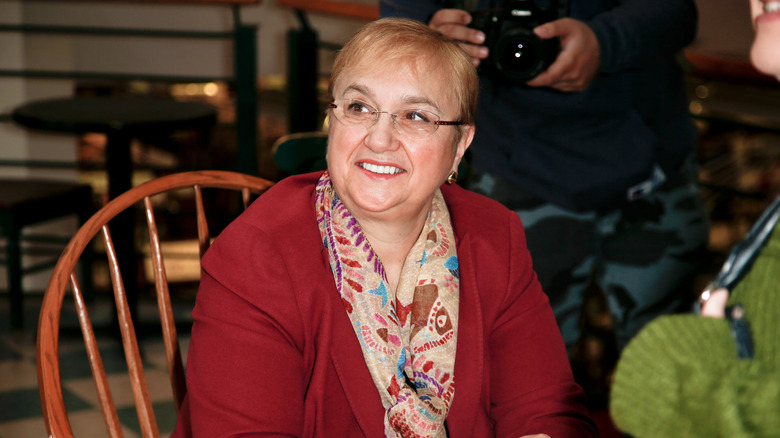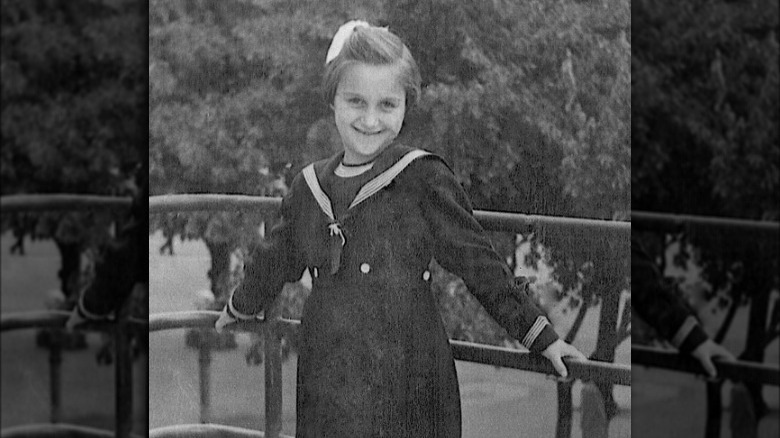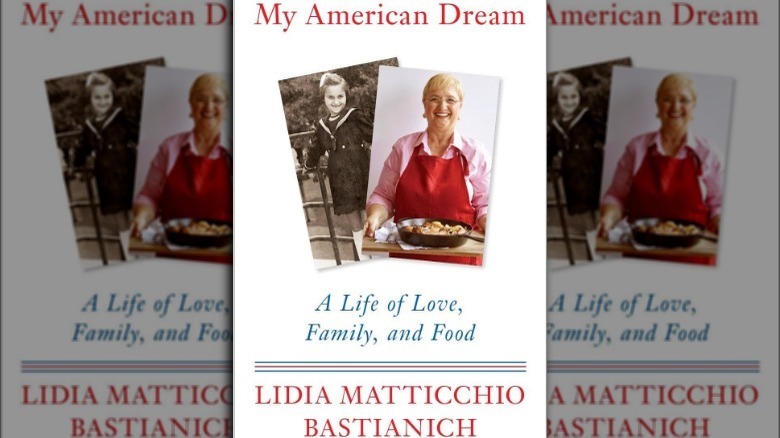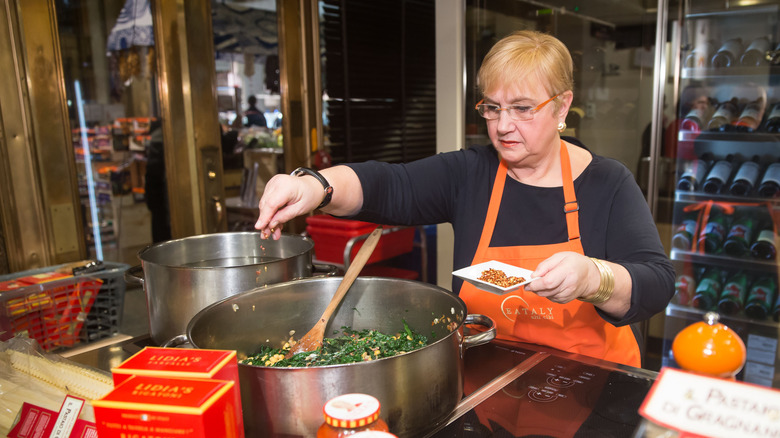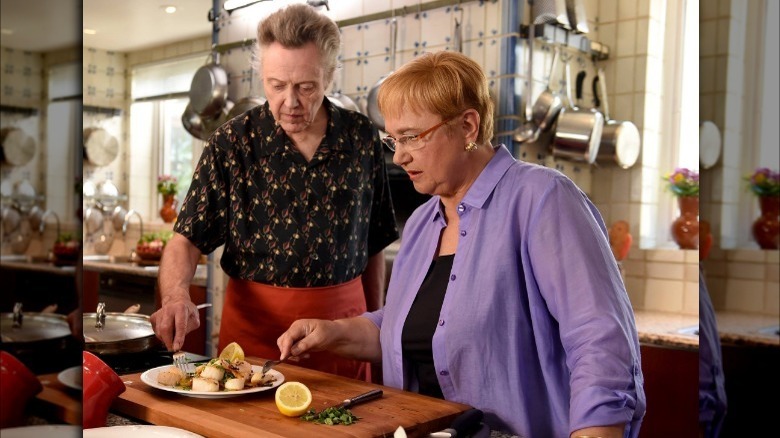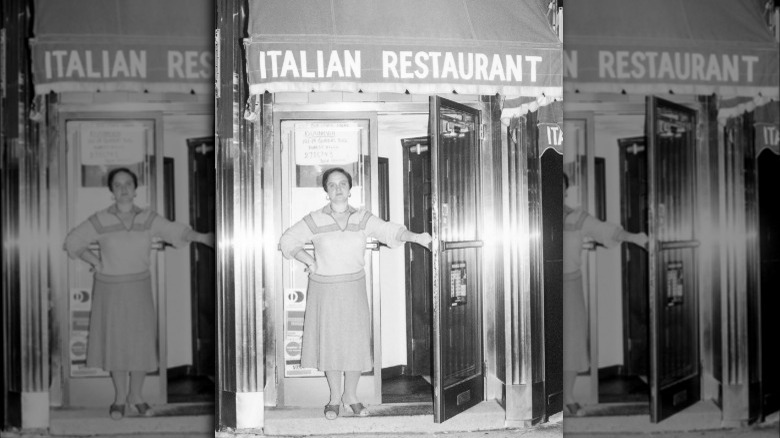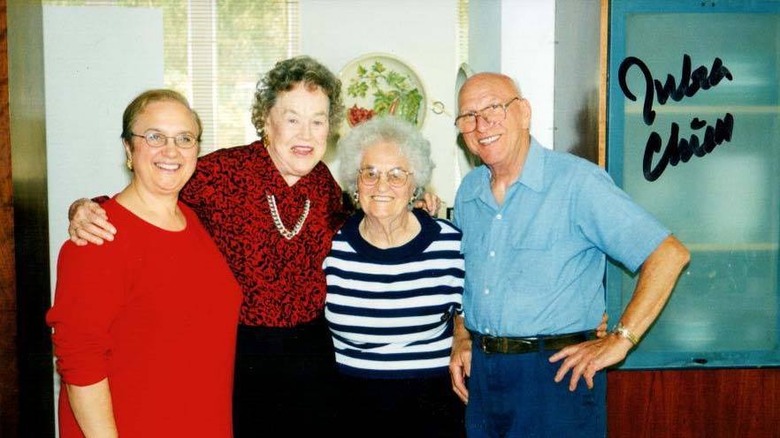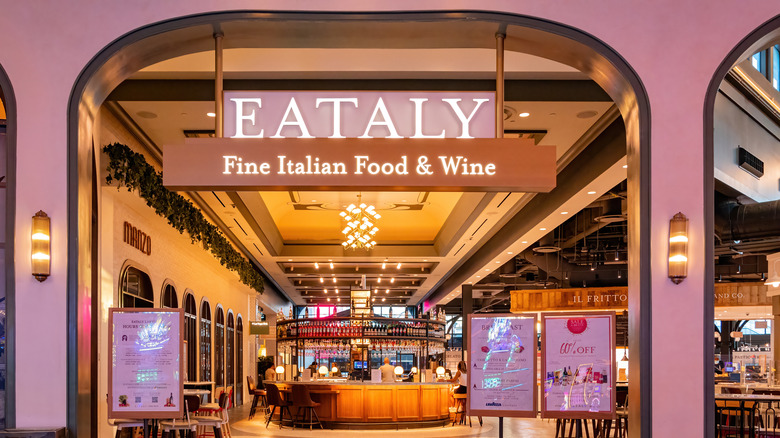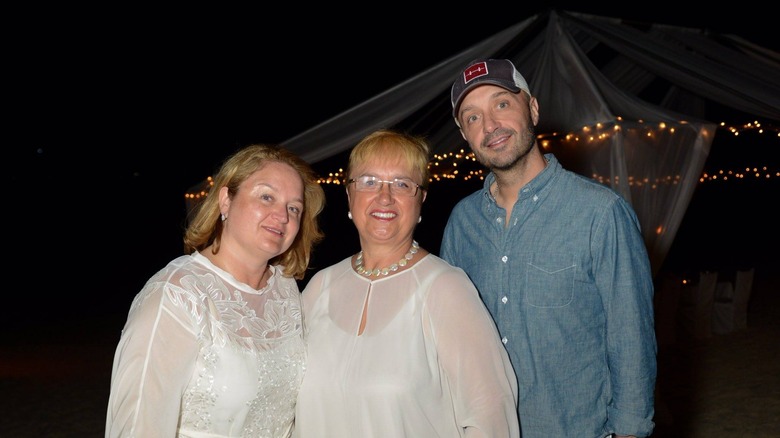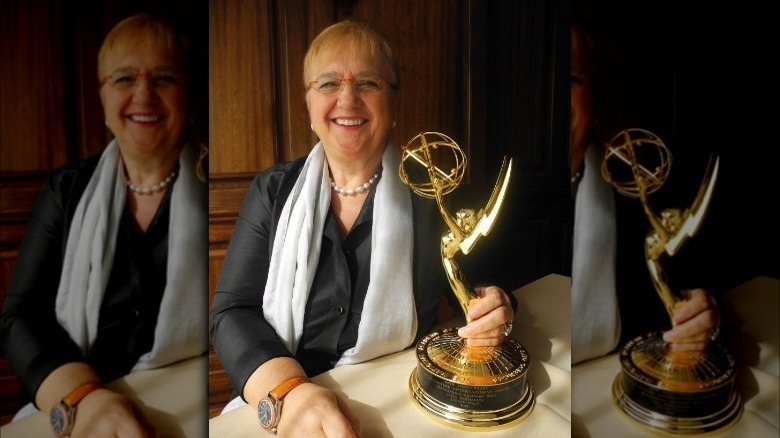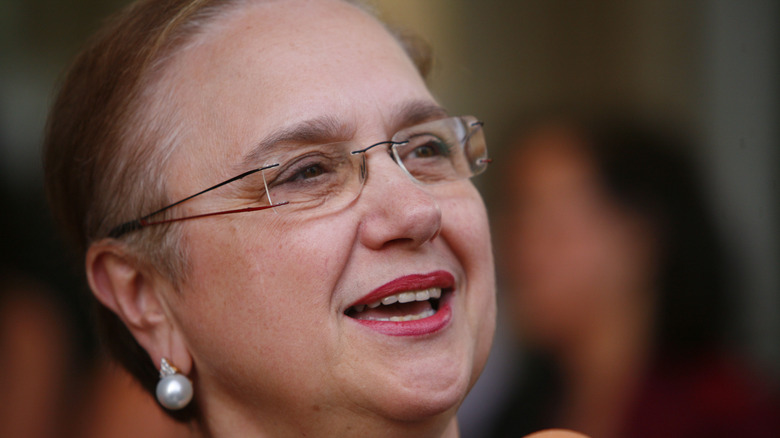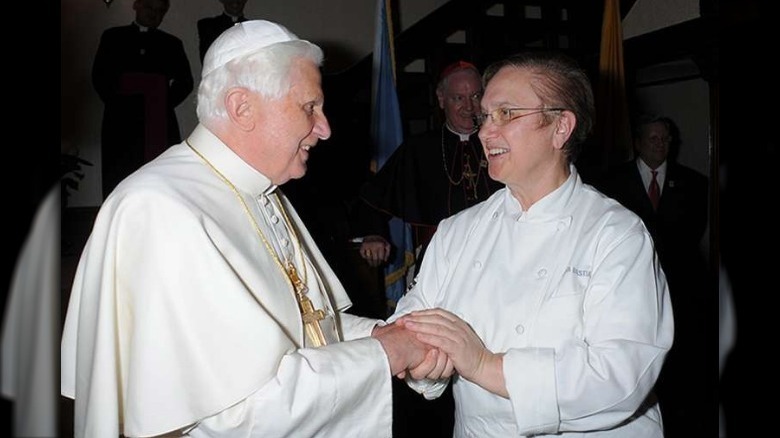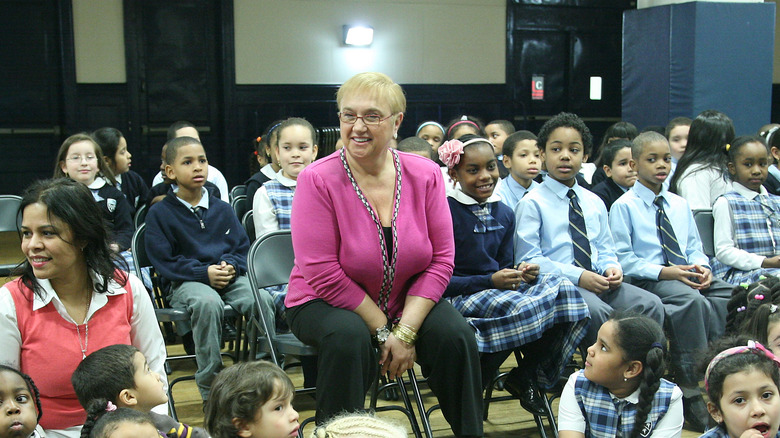Lidia Bastianich's Transformation Is Seriously Turning Heads
With several restaurants, numerous cookbooks, and, most famously, a television career that spans more than two decades, Lidia Bastianich is one of the country's most successful and well-known chefs. But behind the fame and fortune is a fascinating life story that began on the other side of the world. Born into poverty and life under an oppressive government, Bastianich and her family had to flee their hometown before immigrating to America to start their new lives.
The one constant in Bastianich's life throughout this journey was cooking. She got her first job in a kitchen when she was just a teenager in America, and she hasn't stopped cooking since. Now, with multiple restaurants, a line of food products and cookbooks, and the uber-successful Eataly franchise under her belt — not to mention an iconic career in the cooking show arena — it's easy to say that Lidia Bastianich's transformation has been truly remarkable.
Lidia Bastianich was born in post-war Italy
Lidia Bastianich (née Matticchio) was born in 1947 in the town of Pola, also called Pula, located on the southern tip of the Istrian peninsula, which juts into the Adriatic Sea. At the time of her birth, the region was part of Italy, but just months later Istria was given to Yugoslavia as part of the World War II peace treaty. The change in country meant falling behind the Iron Curtain and under communist rule. This would prove to cause Bastianich's family a great amount of strife as time went on.
Nevertheless, Bastianich has fond memories of her childhood. She spent a great deal of time at her maternal grandparents' home. Although the family was poor, they utilized every resource available to them, particularly when it came to food. Bastianich's grandparents produced most of their own food, something young Lidia reveled in helping her grandmother prepare.
Lidia Bastianich was a refugee before becoming a naturalized American citizen
"While life seemed great for me at the time," Lidia Bastianich recalls of her early years in Pola, "what I didn't know as a child was how communism took away almost everything my family stood for." Behind her seemingly idyllic childhood, the outside forces of the world were wreaking havoc on the Bastianich family's way of life. "Communism changed our last name. We couldn't speak our native Italian language. They took away our religion; I even had to be baptized in secret! Communism threatened my dad's business."
The oppression culminated in the family's decision to flee in 1956. They escaped to Trieste, Italy, and spent the next two years in a refugee camp. Then, in 1958, Bastianich's family received a sponsorship from Catholic Charities to move to America. Although she was just 12 years old at the time, Bastianich still fondly remembers the outpouring of support her family received upon landing in New York. "Complete strangers and nonprofit organizations were willing to give us a home, fill our cupboards with food, and find my parents a job," she told the National Italian American Foundation. "There was so much generosity and to this day we have so much gratitude for the people and organizations that helped us when we most needed it."
Lidia Bastianich got her first taste of cooking as a child
Lidia Bastianich's time at her grandparents' home introduced her to all things food at a very young age. From grinding wheat and growing fruits and vegetables to raising animals and making olive oil, there were few culinary tasks the family didn't undertake. "My grandmother raised, made, cured all the food for everyone in the family," she told The Pitch. "That's what they did every day, tending to the pigs, feeding the chickens. So I was in that kingdom of food ... I was connected to food at a very early age. That's remained, and it's my reference library for flavors."
That "reference library" was expansive. Because of the location of Bastianich's homeland, and its political history, the region's food cultures included a vast array of Mediterranean flavors. Even after leaving Pola, those flavors stayed with her, as did her memories of her grandmother. "I was still connected to her through food," Bastianich said. "I cooked what I remembered how to cook. That's my passion and connection."
The aspiring chef got more formal culinary experience after arriving in Trieste. During her two years there, Bastianich spent time with her great aunt, who worked as a personal chef. Young Lidia worked in her aunt's kitchen and explored the city's food market with her. During this time, she also worked in her school's kitchen in exchange for tuition. This was her first culinary experience outside of her family's kitchen.
Lidia Bastianich has a unique connection to Christopher Walken
Of all the unlikely friendships in the world, that of Lidia Bastianich and Christopher Walken certainly ranks high on the list. Believe it or not, these two masters of their respective arts have known each other since they were teenagers. Bastianich's first job after immigrating to America was at Walken's Bakery in Astoria, Queens. The owner and operator of the establishment had a son who also worked there. That young man, named Christopher, just so happened to grow up to become the Academy Award winning actor we all know and love.
The two have remained in touch throughout the decades and Bastianich has even invited her former coworker onto her television shows. On her Home for the Holidays special, Bastianich and Walken cooked a scallop dish that the former named "Scallops A La Walken." On another occasion, Anthony Bourdain joined the pair for a Christmas Eve dinner. The acclaimed trio prepared La Vigilia, a Southern Italian version of the Feast of the Seven Fishes.
Lidia Bastianich opened her first restaurant at age 24, but was not the head chef
By 1971, Lidia Bastianich was ready to open her own restaurant, at least as a businesswoman. That year she and her husband Felice opened a small Italian eatery in Queens called Buonavia, which in Italian means "on the good road." But interestingly, Bastianich did not work as the restaurant's head chef. Knowing that Americans expected Italian-American food, as opposed to her more traditional northern Italian cuisine, Bastianich hired an outside chef. She worked, instead, as the restaurant's sous chef, which allowed her to learn American-style Italian cooking.
The plan worked better than she likely could have imagined. Buonavia was such a success that she and Felice had to expand the restaurant twice. Then, in 1973, the couple opened a second restaurant nearby. Bastianich's entrepreneurial success allowed her to dream bigger. Despite the restaurants' success, the couple sold both of its establishments just a few years later in order to raise money for a new venture: a Manhattan restaurant. In 1981, that dream became a reality when Felidia opened its doors. It quickly garnered rave reviews, including a three-star rating from the New York Times. Lidia Bastianich was now firmly planted on the culinary map.
Lidia Bastianich got her start on television thanks to Julia Child
If opening Felidia in Manhattan wasn't intense enough, just a day in to the new venture, one of the most powerful and influential people in the food world strolled into the restaurant: Julia Child. "She came for the risotto specifically. I cooked the risotto and I was kind of nervous, of course," Bastianich told WGBH. "I don't think I really realized the magnitude. You know, sometimes ignorance is bliss? I was very comfortable. I felt like she was my friend, I had watched her on television."
Unbeknownst to Bastianich at the time, this would be the start of a great friendship and a pivotal career path. Child was apparently so impressed by the food that she asked Bastianich to teach her. The famed chef later visited Bastianich's home to learn how to make risotto. A few years, Child invited Bastianich to appear on two episodes of her Master Chef series, she told WGBH. Inspired by the experience — and her mentor — Bastianich debuted her own cooking show, Lidia's Italian Table, in 1998 and has since become one of the most prominent chefs on television.
Lidia Bastianich has built a full-blown culinary empire
From humble beginnings, Lidia Bastianich has built a culinary empire that rivals any other in the country. Bastianich currently owns two restaurants: Becco in New York City and Lidia's Kansas City. Her most recent — and most notable — business venture, however, is Eataly. Opened in the Flatiron District of Manhattan in 2010, the 50,000-square-foot Italian marketplace features six restaurants, five takeaway counters, two coffee bars, a Nutella bar, fresh pasta counter, bakery, gelateria, and more. It has proven to be so successful that Bastianich and her partners have since opened five more locations across the country, including a second spot in New York, as well as Chicago, Boston, Los Angeles, and Las Vegas.
Between openings, Bastianich has found time to launch her own line of pastas and sauces and publish 13 cookbooks, the most recent of which, "Felidia," includes recipes from her famed restaurant. She has also penned a memoir entitled "My American Dream," detailing her journey as a child to her new homeland.
It's almost easy to forget to mention the job that Bastianich is most well known for –- being a TV host. Since her 1998 debut, the chef has been a mainstay on television, starring in and producing a number of cooking shows, including her most recent, Lidia's Kitchen.
Lidia Bastianich has gone into business with her children
Ever since her early years preparing food with her grandmother, cooking was always a family affair for Lidia Bastianich. That has continued up to this day for the celebrated chef, who works on several of her business ventures with her two children.
Lidia's son Joe is another successful restaurateur, and together, the mother-and-son own Becco, a casual Italian restaurant opened in 1993. Their biggest project together, however, is Eataly.
Not to be outdone by her brother, Lidia's daughter Tanya also co-owns a restaurant with her mother, named Lidia's Kansas City. Additionally, Tanya is a partner at Tavola Productions, the company responsible for producing all of Lidia's cooking shows.
Not only does the family's matriarch clearly enjoy working with her children, she credits much of her success to them. "I wouldn't have grown as much had my children not come in with their new energies," she told Family Business Magazine. "I love working with my children as adults. I took it as a great honor that they saw what I started and wanted to continue. They have different strengths, and it was up to me to incorporate them and let them learn what I had done thus far. Then I let them grow, and they have, each on their own."
Lidia Bastianich has won more awards than you can count
Rest assured that all of Lidia Bastianich hard work has been recognized, and then some. First and foremost are her cooking accolades. In 1999, the James Beard Foundation named Bastianich one of the Best Chefs in America. She had previously been nominated five different times. Since then, the popular chef has been nominated for and won numerous James Beard Awards. And it's not just the James Beard Foundation that has recognized Bastianich's exemplary culinary work. She has also won the prestigious Artusi Prize as well as the Master of the Aesthetics of Gastronomy Award from the Culinary Institute of America, just to name a few.
For her work in front of the camera, Bastianich has received the highest award in the television industry: In both 2013 and 2018, she won the Daytime Emmy for Outstanding Culinary Host, first for Lidia's Italy and then Lidia's Kitchen. She and Bobby Flay are the only two people to win the award twice. Her TV job has also garnered her Telly, Taste, and New York Festivals Awards.
Lidia Bastianich hasn't been immune to controversy
Being a public figure these days means facing down at least a few controversies, even if you're someone as wholesome as Lidia Bastianich. It turns out the famed chef has had her share of bad publicity over the past few years.
The most notable event occurred in 2011 when Bastianich was accused of enslaving an Italian chef. Yes, you read that correctly. In a suit filed, the plaintiff claimed that Bastianich hired her as a home attendant under the guise of promising her work in a restaurant. Instead, she allegedly received no culinary experience and no paycheck –- for six years. Although the case was originally thrown out, an appellate court found that, indeed, Bastianich should have paid her employee.
That's not the only lawsuit centered on missing wages that Bastianich has been a part of. On more than one occasion, she and her partners have agreed to multi-million-dollar settlements stemming from lawsuits by their restaurant employees. In each case, staff claimed that the owners withheld their pay, either by not paying them for all the hours they worked or by withholding tips.
Lidia Bastianich has cooked for two popes
Most celebrity chefs can rattle off a pretty impressive list of pretty impressive people they have cooked for. But you'll be hard pressed to find one that has prepared a meal for a pope. In true iconic fashion, Lidia Bastianich has cooked for not one, but two popes.
In 2008, she was asked to cook for Pope Benedict XVI. "I didn't believe it was going to happen," she told Catholic News Agency. "I remember I laughed and said, sure, Monsignor, I would love to, but is that a reality?" It was a reality, and Bastianich wound up cooking two dinners for the pope. The first night's menu included string bean salad, ravioli, risotto, whole roasted striped bass, and an apple strudel dessert. For the second night, which happened to be the pope's birthday, Bastianich prepared a beef goulash and cake for dessert.
Just a few years later, in 2015, Bastianich was bestowed the honor of cooking for a second pope. She prepared all of Pope Francis' meals during his visit to New York. Meals included dishes such as house-made burrata, steamed lobster, capon soup, veal medallions, pecorino-filled ravioli, roasted striped bass, concord grape sorbet, and angel food cake.
Lidia Bastianich continues to give back
Lidia Bastianich has reaped the rewards of an extremely successful career, and she's made sure to share her good fortune. Inspired by those who helped her and her family many years ago, the former refugee has made it a point to aid those in a similar position to where she was as a child. "Along the way, a lot of people helped us. When I was in camp there was a woman who helped pay for my schooling. When we moved here, Catholic Services found us a place to live," she told The Pitch. "I know what it means, and I appreciate it. So when I see a need someplace, I feel it."
Notably, Bastianich became the United Nations Association of the USA's first celebrity champion for refugee youth education in 2018. In her role, she supports and raises funds for Adopt-A-Future, a campaign that works to provide refugee children with an education.
Bastianich has also worked extensively with the United Nations Development Fund for Women, being the face of the "Say No to Violence Against Women" campaign, working to raise awareness about female refugees in war-torn Kosovo, and establishing the UNIFEM/International Alert Millennium Peace Prize for Women.
